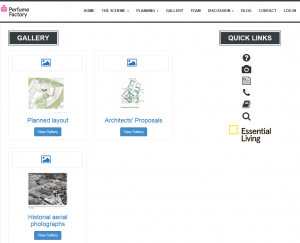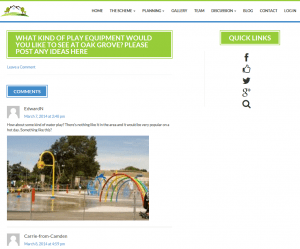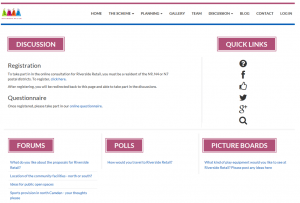In the first section of this series of blogs, I explained that my role in providing an online consultation service is to run a good consultation, not simply to get good results.
This series of posts focusses on how the principles of best practice in communication can be applied to online consultation and uses Scotch Corner Designer Village as a case study. If you haven’t already seen it, please have a look at Scotch Corner Designer Village. Let me have any feedback – constructive criticism is very much appreciated!
Visionary
Working with a community to develop a vision is the basis of consultation but the extent to which the community can determine that vision is debateable. The Community Planning website warns against unrealistic visions:
Nothing much is likely to be achieved without raising expectations. Yet dwelling entirely on the utopian can be frustrating. Strike a balance between setting visionary utopian goals and being realistic about the practical options available.
Having run many consultations on behalf of property developers, I would suggest that entrusting the development of a vision to the local community is a step too far on the Ladder of Participation. In development, vision is limited by both planning restrictions (such as density, height, massing and unit size) and economic viability. Excellent consultation does not offer a community a blank canvas on which to create its vision but manages a constructive dialogue: communicating a clear statement of the purpose, clarification of the constraints, the statutory policy framework and the way in which the results will be used.
The importance of professionals, who possess an understanding of long term implications must be carefully balanced against ‘people’ power, according to Bristol City Council:
Councillors and officers will often have to make their own judgement about the weight to be given to one or other of the views expressed. They may also have to consider carefully whether the aspirations and needs of future generations – who will perhaps be most affected by any change – might differ significantly from those of today’s population.
Websites are well placed to communicate a vision and to encourage others to share in it. The Home page of a ConsultOnline website shows an inspiring image of the proposed development alongside text designed to engage:
The vision is not solely that of the consultor’s, however: the consultee is encouraged to post images and enter into a wide range of discussion forums:
Appropriate selection of tactics
The methods selected are vital to an inclusive and accessible consultation. There is no single ‘right’ method and given the range of stakeholders in any one community, a variety is always necessary.
With the advent of online communication, the extensive toolbox of consultation techniques has expanded considerably. Excellent consultation should focus on those techniques which elicit the most through responses and produces the most discernible results.
Choosing the most appropriate tactics is at the heart of excellent consultation. It may be suggested that online consultation is a single tactic, but I would dispute this. The ConsultOnline service enables users to receive information in the form of text, images, video and weblinks, and to interact though polls, forums, picture boards, posting questions, and commenting on blogs and videos. Beyond the website, the service also enables communication via Facebook, Twitter and. Above all, ConsultOnline aims to communicate with people in a way that is deliberately interactive, enjoyable and user-friendly.
In The Art of Consultation, Rhion Jones and Elizabeth Gammell support the view that online consultation can attract users’ attention because of its innovative nature:
Part of the problem is that so many of the traditional methods are regarded as passé. They have been done to death and the novelty has worn off. Questionnaires are a case in point. Experienced consultors know that there is far more to consultation than surveys and recognise that quantitative data is frequently less useful than the qualitative variety.
I do not assume, however, that everyone prefers to communicate online, which is why ConsultOnline has operated alongside meetings with groups, newsletters and public exhibitions. One day online consultation may replace traditional consultation entirely but we are only at the very beginning of that process.
Penny Norton
Penny’s book Public Consultation and Community Involvement in Planning: a twenty-first century guide is published by Routledge in June 2017. Please email Penny to receive notification of its publication.




